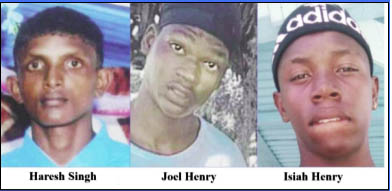
October 15 ,2020
Acting Commissioner of Police Nigel Hoppie yesterday said that investigators are currently pursuing new leads as they continue to investigate the murders of teenaged cousins Isiah and Joel Henry, who were killed more than a month ago at Cotton Tree, West Coast Berbice (WCB).
While he refused to divulge any other details, Hoppie reiterated that no stone will be left unturned during the investigation.
“There are efforts ongoing to ensure that no stone is left unturned as we pursue this matter…I have stated earlier and I would like to reiterate that no stone will be left unturned in addressing this matter,” he said.
Hoppie made this disclosure on the sidelines of the commissioning of the Brickdam Police Station lockups yesterday afternoon.
He added that the police are still awaiting the results from DNA samples which were sent to St. Lucia for testing along with a report from the five-member team from the CARICOM Regional Security System (RSS), which recently visited to assist with the investigation.
According to Hoppie, both the DNA results and the RSS report are expected “shortly”.
He said local police are in contact with the officials from the lab to ensure that the results arrive here “quickly as possible” so that the investigation can proceed in a “positive” direction.
Stabroek News had previously reported that the RSS team, which arrived here on September 28, departed October 5th. The team comprised officials from countries within the Regional Investigative Management System.
A second high-level forensic team from Argentina is also expected to visit here to assist with the investigation into the murders. However, Hoppie said a time has not yet been finalised for this visit. “But we are still engaging the persons with a view of ensuring that the experts arrive here to bring this matter to finality,” the acting Top Cop stated.
Isaiah, 16, a student at the Woodley Park Secondary School, and Joel, 18, who worked at the Blairmont Estate, went missing on Saturday, September 5, after they left home for the Cotton Tree backlands to pick coconuts.
After they did not return home, relatives lodged a missing-persons report with the police and subsequently launched a search. It was while searching that the bodies of the teens were discovered. The discovery of the bodies sparked days of unrest in West Berbice.
Autopsies performed on the bodies of the teenagers showed that they both died from haemorrhage and shock due to multiple wounds.
Days after this, another teenager, Haresh Singh, was also murdered in what is believed to be a reprisal killing.
The teams will be assisting the Guyana Police Force with the investigation into the murders of the Henrys as well as Singh.
More than a month ago, the police had said that investigations revealed that the Henrys were not killed at the location where their bodies were found.
The police had said that the bodies of the cousins were found about 600 feet from each other in clumps of bushes near a coconut farm on the WCB. “…Prelimi-nary findings showed that the bodies of the Henry boys were discovered at a secondary crime scene,” the police in a statement had said.
This means that the heinous murders were not committed where the bodies were found. “Person(s) moved the bodies after the murder and placed them at the locations where they were subsequently discovered,” the police added.
Forensic evidence was found at the secondary crime scene and has since been collected, preserved and submitted to the Guyana Forensic Science Laboratory (GFSL) for DNA analysis.
The police had also said that DNA samples were also collected from the suspects who were in custody and sent for a comparative analysis to be conducted against the forensic evidence collected from the secondary crime scene.
Director of the GFSL, Delon France, had previously told Stabroek News that the standard turnaround time for samples to be processed upon receipt is 30 days. However, France had said he has related to the police that the results from the Henrys’ case should be available in three weeks.
France had subsequently told Stabroek News that a decision was taken to send the samples overseas due to the urgency to have the results as soon as possible.
